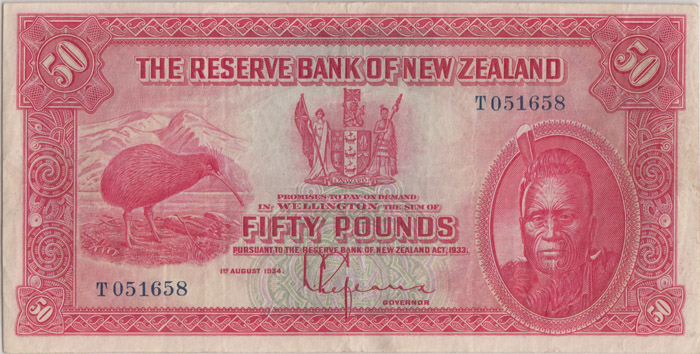Lot 396


Pick#157. Extremely Rare
-
Medium:
- Coins, Money & Stamps Notes:
- In 1901, genteel New Zealand chose not to join up with the ‘wild colonial boys’ in a Federated Australia and continued on as a colonial outpost of the British Empire up until the mid-1940s. It had signed on to the League of Nations in 1920 not in its own right but as a Dominion of the British Empire, and although the Balfour Declaration of 1926 which was legislated in the Statute of Westminster in 1931 offered it independence over all its military and foreign affairs, it did not completely cut the apron strings of ‘Mother England’ until 1947. The progress of a nation is traditionally exalted in its coin and banknotes designs, and this probably explains why New Zealand, which was slow to claim nationhood, continued to circulate British coins until 1933, and persisted with banknotes issued by the largely overseas controlled private trading banks until the Reserve Bank of New Zealand was finally established in 1934. The first national banknotes released in August of that year carried the signature of Leslie Lefeaux, an assistant to the Governor of the Bank of England, who was anointed the first Governor of the Reserve Bank of New Zealand. The notes were produced on the fly by the London firm of Thomas de la Rue and were only expected to be ‘temporary’ issues that would be quickly replaced with more considered designs. All the denominations of this rushed issue were of the one size and featured on the front the same design of a ‘Kiwi’, the ‘Arms of New Zealand’ and the ‘tattooed face of the Maori King Tawhao’ - and on the back the famous aspect of ‘Mitre Peak’ reflected on ‘Milford Sound’. For continuity the colours used on the denominations mirrored those used on the standardised trading bank issues that they replaced and, so like the folklore that attaches to the old American greenbacks, there were supposedly confused people being passed an orange Ten Shillings instead of a red £50 and visa-versa. Despite the best of plans these ‘temporary’ notes would not be replaced until 1940 when the new ‘permanent’ designs were finally introduced. Suffice to say that all of the ‘Lefeaux’ signature banknotes were heavily circulated and none more so than the £50 of which it is estimated that less than 50 of the original 50,000 have survived. The £50 is a world-class banknote rarity and most survivors are found in poorer grades with multiple pin holes, heavy creases, torn or with frayed edges, and so it is unusual to find a problem free intact note. The note on offer has been conservatively graded PCGS 25 (Very Fine) with no flaws noted. Tellingly the serial number of the note is T 051658, a number well above the number issued i.e. 50,000 which would suggest that a significant number of notes were spoiled during the print run of 1934. In our search through Auction archives it is also the highest serial number of an issued note that we have been able to locate, which only adds to its rarity.
Accepted Forms of Payment:
American Express, MasterCard, Money Order / Cashiers Check, Paypal, Visa, Wire Transfer
Shipping
AUSTRALIA: Purchases within Australia will be charged a MINIMUM SHIPPING FEE of $5.50 and will be sent by Registered Post. Additional insurance is optional at the buyer's expense.
INTERNATIONAL: Overseas purchases will be charged a MINIMUM SHIPPING FEE of $20.00 and will be sent by Registered Post International. Additional insurance is optional at the buyer's expense.
Both Australian and International packages are traceable in transit and require a signature on delivery.
Smalls Auctions
You agree to pay a buyer's premium of up to 18.5% and any applicable taxes and shipping.
View full terms and conditions
| From: | To: | Increments: |
|---|---|---|
| A$0 | A$99 | A$5 |
| A$100 | A$999 | A$10 |
| A$1,000 | A$4,999 | A$50 |
| A$5,000 | A$9,999 | A$100 |
| A$10,000 + | A$250 |





